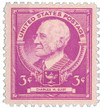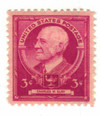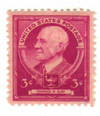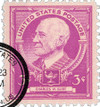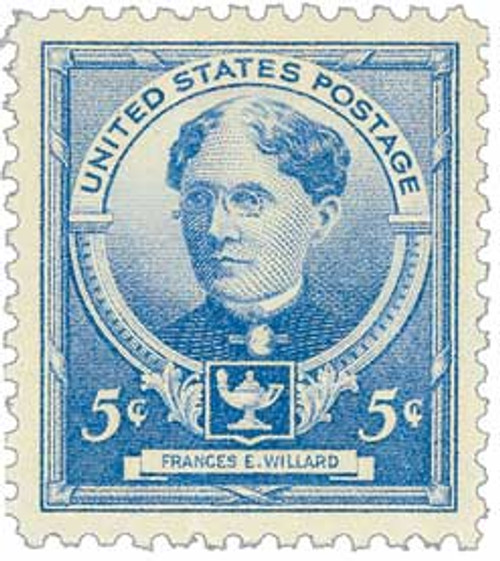
1940 Famous Americans: 3c Charles W. Eliot
# 871 - 1940 Famous Americans: 3c Charles W. Eliot
$0.35 - $35.00
U.S. #871
1940 3¢ Charles William Eliot
Famous Americans Series – Educators
1940 3¢ Charles William Eliot
Famous Americans Series – Educators
Issue Date: March 28, 1940
First City: Cambridge, Massachusetts
Quantity Issued: 51,636,270
Printed by: Bureau of Engraving and Printing
Printing Method: Rotary Press
Perforation: 10 ½ x 11
Color: Bright red violet
First City: Cambridge, Massachusetts
Quantity Issued: 51,636,270
Printed by: Bureau of Engraving and Printing
Printing Method: Rotary Press
Perforation: 10 ½ x 11
Color: Bright red violet
Pictured on U.S. #871, Charles Eliot’s tenure at Harvard University saw it transformed into a premiere research institution. Eliot spent two years in Europe studying all aspects of education systems there. He was particularly impressed with the use of research at universities by German businesses.
In 1869, Eliot published an article in “The Atlantic Monthly” called “The New Education.” He wrote, “We are fighting a wilderness, physical and moral. For this fight we must be well trained and armed.” That same year Eliot became the youngest president of Harvard, at age 35. He served as president for 40 years, reforming the university and empowering Harvard’s rise to the forefront of American institutions.
Famous Americans
In 1938, the Post Office Department announced plans for a series of stamps recognizing 10 famous Americans and invited the public to submit recommendations. The response was so great that it was decided to increase the number from 10 to 35. This required an unexpected level of organization by the Post Office Department for this series.
Seven categories were decided upon – authors, poets, educators, scientists, composers, artists, and inventors. Each category of five has the same set of denominations – 1¢, 2¢, 3¢, 5¢, and 10¢. Each rate had a valid use. The 1¢ stamp paid for a letter that was dropped off at a post office to someone who had a box at the same office. The 2¢ was for local delivery. The 3¢ paid the normal non-local mail rate, and the 5¢ and 10¢ were used in combination for heavier letters and special rates. The denominations also shared a consistent coloring scheme: 1¢ is bright blue green; 2¢ is rose carmine; 3¢ is bright red violet; 5¢ is ultramarine; and 10¢ is dark brown.
Each category has its subjects arranged with the oldest birth date going on the 1¢ stamp, down to the most recent birth date on the 10¢ stamp. Each category has its own dedicated symbol in the engraving – a scroll, quill pen and inkwell for authors; a winged horse (Pegasus) for poets; the “Lamp of Knowledge” for educators; laurel leaves and the pipes of the Roman god Pan for composers; and inventors had a cogwheel with uplifted wings and a lightning flash to symbolize power, flight, and electricity.
The artists and the scientists have multiple symbols. Artists have either a paint palette and brush (for painters), and the sculptors have a stonecutting hammer and chisel. Scientists had the classical symbol of their particular profession.
U.S. #871
1940 3¢ Charles William Eliot
Famous Americans Series – Educators
1940 3¢ Charles William Eliot
Famous Americans Series – Educators
Issue Date: March 28, 1940
First City: Cambridge, Massachusetts
Quantity Issued: 51,636,270
Printed by: Bureau of Engraving and Printing
Printing Method: Rotary Press
Perforation: 10 ½ x 11
Color: Bright red violet
First City: Cambridge, Massachusetts
Quantity Issued: 51,636,270
Printed by: Bureau of Engraving and Printing
Printing Method: Rotary Press
Perforation: 10 ½ x 11
Color: Bright red violet
Pictured on U.S. #871, Charles Eliot’s tenure at Harvard University saw it transformed into a premiere research institution. Eliot spent two years in Europe studying all aspects of education systems there. He was particularly impressed with the use of research at universities by German businesses.
In 1869, Eliot published an article in “The Atlantic Monthly” called “The New Education.” He wrote, “We are fighting a wilderness, physical and moral. For this fight we must be well trained and armed.” That same year Eliot became the youngest president of Harvard, at age 35. He served as president for 40 years, reforming the university and empowering Harvard’s rise to the forefront of American institutions.
Famous Americans
In 1938, the Post Office Department announced plans for a series of stamps recognizing 10 famous Americans and invited the public to submit recommendations. The response was so great that it was decided to increase the number from 10 to 35. This required an unexpected level of organization by the Post Office Department for this series.
Seven categories were decided upon – authors, poets, educators, scientists, composers, artists, and inventors. Each category of five has the same set of denominations – 1¢, 2¢, 3¢, 5¢, and 10¢. Each rate had a valid use. The 1¢ stamp paid for a letter that was dropped off at a post office to someone who had a box at the same office. The 2¢ was for local delivery. The 3¢ paid the normal non-local mail rate, and the 5¢ and 10¢ were used in combination for heavier letters and special rates. The denominations also shared a consistent coloring scheme: 1¢ is bright blue green; 2¢ is rose carmine; 3¢ is bright red violet; 5¢ is ultramarine; and 10¢ is dark brown.
Each category has its subjects arranged with the oldest birth date going on the 1¢ stamp, down to the most recent birth date on the 10¢ stamp. Each category has its own dedicated symbol in the engraving – a scroll, quill pen and inkwell for authors; a winged horse (Pegasus) for poets; the “Lamp of Knowledge” for educators; laurel leaves and the pipes of the Roman god Pan for composers; and inventors had a cogwheel with uplifted wings and a lightning flash to symbolize power, flight, and electricity.
The artists and the scientists have multiple symbols. Artists have either a paint palette and brush (for painters), and the sculptors have a stonecutting hammer and chisel. Scientists had the classical symbol of their particular profession.





